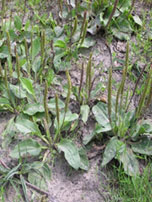SHAHEED KARTAR SINGH SARABHA AYURVEDIC MEDICAL COLLEGE & HOSPITAL
Affiliated to Guru Ravidas Ayurved University, Hoshiarpur Punjab
Affiliated to Guru Ravidas Ayurved University, Hoshiarpur Punjab

Botanical Name : Plantago major
Family : Plantaginaceae
Names in different languages :
English : Broad Leaf Plantain, Greater Plantain, Common Plantain
Hindi : Lahuriya, Luhuriya
Mizo : Kelba-an
Tamil : Ishappukol vitai
Urdu : bartang
Assamese : Singa gach
Sanskrit : Asvagola
Nepali : Isabagol
DESCRIPTION OF THE PLANT :
Broad leaf plantain is a perennial herb, variable with short stout, erect, truncate, rootstocks and numerous adventitious roots.
Leaves appear in rosettes, spirally arranged, stalked, sometimes not clearly distinguished into stalk and the blade.
Leaves are ovate-elliptic or rarely circular, 10-20 cm long, 4-9 cm broad, rounded at the tip, entire, nearly entire or slightly toothed, 3-9 nerved, nerves divergent at the base.
Leaf bases taper into long sheathing stalks usually equalling the blade. Leafless flowering stems are many, 13-15 cm long, arched, erect.
Flower spikes are dense or lax, slender, narrow-cylindric, 5-15 cm long. Bracts are equal to or shorter than the sepal cup, ovate-oblong, acute, brownish with a brown keel.
Sepals are broadly elliptic, oblong to rounded obtuse. Flowers are greenish or yellowish white, 2-4 mm long, petals elliptic-ovate to narrowly triangular, 1-1.15 mm long, obtuse or acute, reflexed.
Anthers are at first lilac, later whitish or yellowish.
Flowering: August-October.
THERAPEUTIC USES :
P. major is used for different purposes in traditional medicine around the world, therefore, researchers have tested it for different types of biological activities. Most tests have been performed on crude extracts without examining the nature of the active compounds. The results of these studies are listed below and include both positive and negative results.
Antiulcerogenic activity :
P. major has been used in Turkey in the treatment of ulcers. The powdered dried leaves were taken together with honey daily before breakfast. A water immersion-stress ulcer model was used on rats to test the plant extract’s ability to inhibit ulcers. A test sample was given just before immobilisation in a stress cage. After 7 h immersed in a water-bath the rats were killed and the stomachs were taken out for examination. The combined methanol- and water extract (1.2 g/kg) inhibited ulcer formation by 40% relative to the control group which received only the vehicle. The water extract (1 g/kg) inhibited ulcer formation by 37% and the methanol extract inhibited it by 29%. P. major was not among the most active plants tested (Yesilada et al., 1993).
Anticancer activity :
In a screening of anticancer activity of Chilean plants a 50% ethanol extract of leaves, stems and seeds of P. major had no activity in vivo against lymphocytic leukaemia in mice (Bhakuni et al., 1976).
A P. major preparation was reported to be effective in a screening system for prophylactic oncology. The effect included antimetastatic activity in models of tumour metastasis in mice. The details in this study were not described (Yaremenko, 1990). In another study, an aqueous extract was shown to have a prophylactic effect on mammary cancer in mice (Lithander, 1992). The leaves were extracted with phosphate buffer pH 7 containing 0.9% NaCl and injected subcutaneously in mice of the C3H Strong strain. Among mice of this strain more than 90% develop cancer induced by a virus infection. After 60 weeks, 93.3% of the untreated and 18.2% of the treated mice had tumours. The observed effect is thought to be due to stimulation of the immune system rather than a direct effect on the virus. No experimental results support this idea, only some observations made without experimental verification. The P. major extract had good effect on human herpes infections but had no effect on the herpes virus in in vitro tests. The same observations have been made for bacteria; only weak antibacterial activity of P. major extracts in vitro, but they had an effect on infected wounds in vivo. While antibiotics on infected wounds had no effect, topical treatment with P. major extract eradicated the infections and healed the wounds.
Immunomodulatory activity :
The leaves extracted in saline for 2 h at 50°C had chemotactic activity on neutrophils using the Boyden migration chamber method, but it did not enhance neutrophil intracellular killing activity by the nitrozoblue tetrazolium reduction test (Basaran et al., 1997).
Antibiotic and antifungal activity :
P. major has been included in screening studies of plants used in folk medicine in fighting bacterial and fungal infections in the skin or in the treatment of gastrointestinal disorders.
Discs containing plant extracts were applied to bacteria cultured on agar plates, and the inhibition zones measured after some time. Water extracts, methanol extracts, 50% and 70% ethanol extracts were tested.
The methanol extracts were most active against Salmonella typhimurium and had weaker activity against methicillin resistant S. aureus and M. phlei. The methanol extracts were active (8–10 mm inhibition zone) against the fungi F. tricuictum and M. gypseum, and an incomplete inhibition of C. albicans and S. cerevisiae was observed. The antifungal activity was weaker than the antimycoticum nystatin (15–20 mm inhibition zone).
